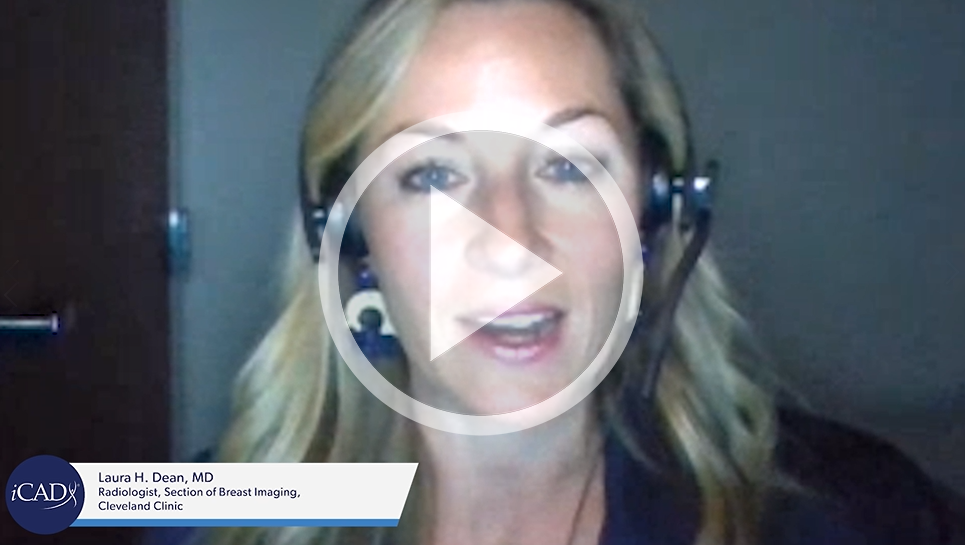How Cleveland Clinic is Finding the Breast Cancers Radiologists Fear the Most

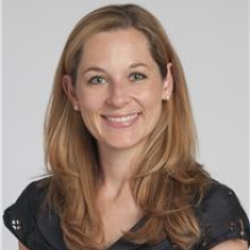
Laura H. Dean, MD Radiologist, Section of Breast Imaging, Cleveland Clinic
Challenge:
Facility upgraded to digital breast tomosynthesis (DBT) in 2016 and sought to further improve cancer detection, reduce workload, and reduce variability across its team of 17 specialized breast imaging radiologists.
Solution:
ProFound AI for Digital Breast Tomosynthesis and PowerLook Density Assessment
Results:
ProFound AI empowered clinicians at the facility to find small, subtle cancers, which tend to be the types of tumors radiologists fear the most. PowerLook Density Assessment simplified and standardized breast density assessments, reducing variability and supporting the facility’s compliance with the national dense breast reporting standard.
The story of the Cleveland Clinic
Based in Cleveland, Ohio, the Cleveland Clinic is a nonprofit multispecialty academic medical center and one of the nation’s top hospitals, according to U.S. News and World Report. The facility offers a comprehensive array of women’s healthcare services, including breast cancer screening and diagnostic imaging. Each year at the clinic, approximately 120,000 mammograms are read by a team of 17 highly skilled breast imaging specialists.
ProFound AI is a game-changer, helping us more confidently and efficiently move through cases, and with more accuracy than ever before. Whether recommending a biopsy or confidently dismissing a case, ProFound AI empowers our team with crucial insights that aid in clinical decisions. – Laura H. Dean, MD
Recognized for its dedication to excellence, the Cleveland Clinic remains at the forefront of medical advancements. The organization began offering mammograms with digital breast tomosynthesis (DBT) in 2016, but the team soon found the transition from 2D mammography resulted in a significant increase in workload.
The organization adopted ProFound AI and PowerLook Density Assessment in early 2020, in an effort to improve efficiency while maintaining clinical excellence. Incorporation of this new technology offers radiologists at the facility a cutting-edge solution that is revolutionizing their approach to breast cancer detection.
Embracing the Power of iCAD’s Breast AI Suite
Dr. Laura Dean, an esteemed radiologist at the clinic, shares how her impressions of ProFound AI changed over time. “At first, I was skeptical, due to past limitations of traditional CAD algorithms, but we soon became believers. There was definitely a learning curve, but through training sessions I learned how to interpret the marks, and after learning from a number of interesting cases, we began to trust it more. While just a few years ago I was completely disregarding CAD, now ProFound AI is a significant part of my search pattern.”
Dr. Dean says her team has found the technology offers value in both screening and diagnostic exams. “ProFound AI is a game-changer, helping us more confidently and efficiently move through cases, and with more accuracy than ever before. Whether recommending a biopsy or confidently dismissing a case, ProFound AI empowers our team with crucial insights that aid in clinical decisions.”
Dr. Dean says PowerLook Density Assessment has also transformed patient care in recent years. “Traditionally, breast density assessments are performed with a visual assessment, which can be quite subjective. For example, if a woman’s mammogram shows her breasts are right on the border of being either on the high end of scattered fibroglandular or the low end of heterogeneously dense, she might have one radiologist tell her she has dense breasts one year and a different radiologist disagree the next. But with PowerLook Density Assessment, it is easier for our team to analyze and quantify breast density more objectively and reliably,” she explained.
And with the FDA’s decision to implement a national breast density reporting standard, effective September 2024, Dr. Dean says this technology is more relevant than ever.
“In the past it might not have made much of a difference whether a woman’s density was scored differently from year to year, but now it makes a big difference. ProFound Density offers our team critical information that helps us to determine whether a woman may be a potential candidate for supplemental screening, such as ultrasound or MRI.”
“Given that dense breast tissue is a known independent risk factor for developing breast cancer, the ability to tailor a woman’s screening based on her density, and therefore her risk, is an important part of personalized medicine.”
A Second Reader for Enhanced Accuracy, Speed, and Confidence
After using iCAD’s Breast AI technology for several years, Dr. Dean says it has transformed the way she reads mammography. “I used to test myself and read a mammogram without ProFound first, but now, after using the technology for a few years, I always incorporate the Profound case score information at the start of a case,” she continued. “This has allowed me to be more efficient in my mammogram interpretations. In addition, ProFound AI acts as an extra set of eyes, almost like a second reader. It encourages a “pause” for radiologists and helps to eliminate bias and satisfaction of search.”
Dr. Dean says ProFound’s ability to detect even the most small, subtle and invasive cancers is remarkable. “Even for experienced radiologists, some findings are so subtle they can be difficult to detect. These are the cancers we radiologists fear the most – the ones that could have been easily missed,” she continued. “But I have now seen quite a few cases where ProFound Detection helped me find something that might not have been detectible for a couple of years, or could have presented as an interval breast cancer had we not made the earlier diagnosis. This reliable, game-changing technology has not only improved our confidence, but it is also enhancing patient care at the Cleveland Clinic like never before.”
Case #1: ProFound detects very small invasive ductal cancer in 46-year-old woman.
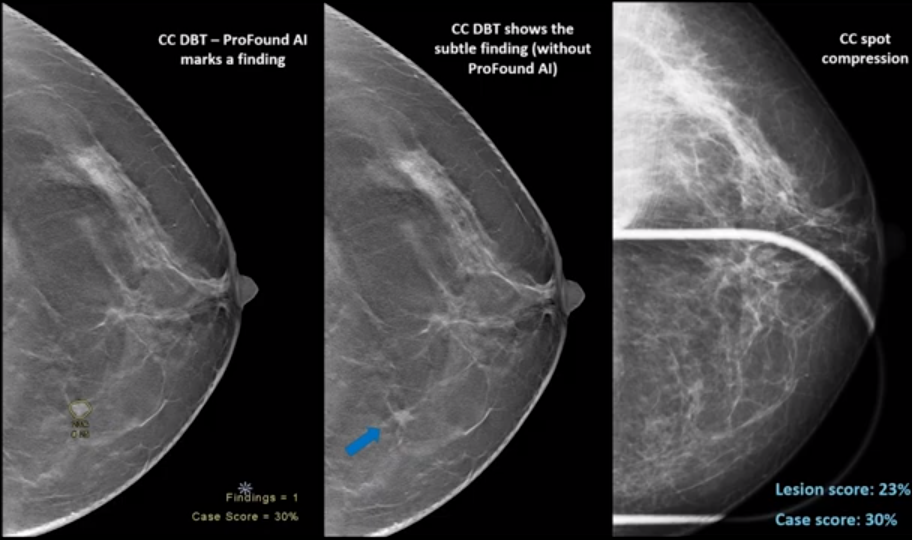
Case #2: ProFound detects invasive lobular carcinoma in a 51-year-old woman two years prior to radiologists.
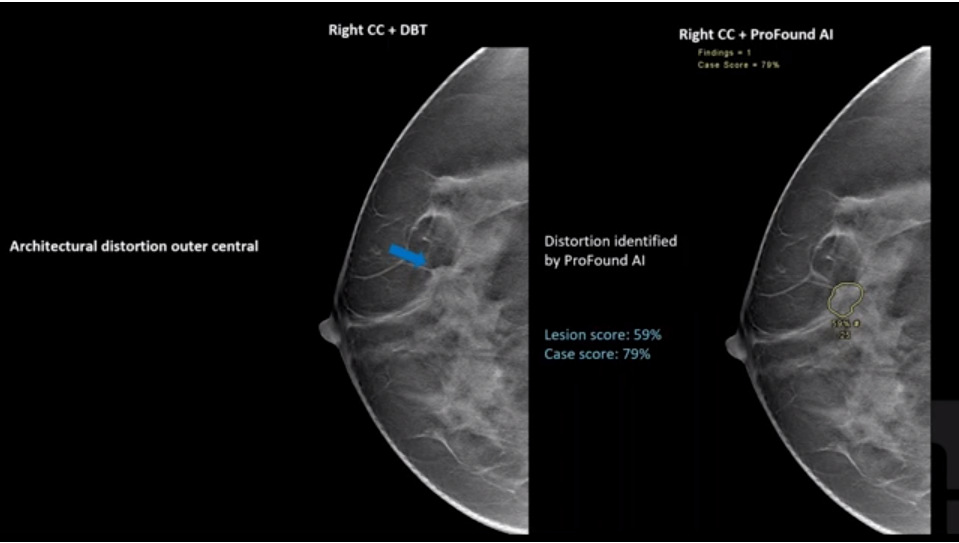
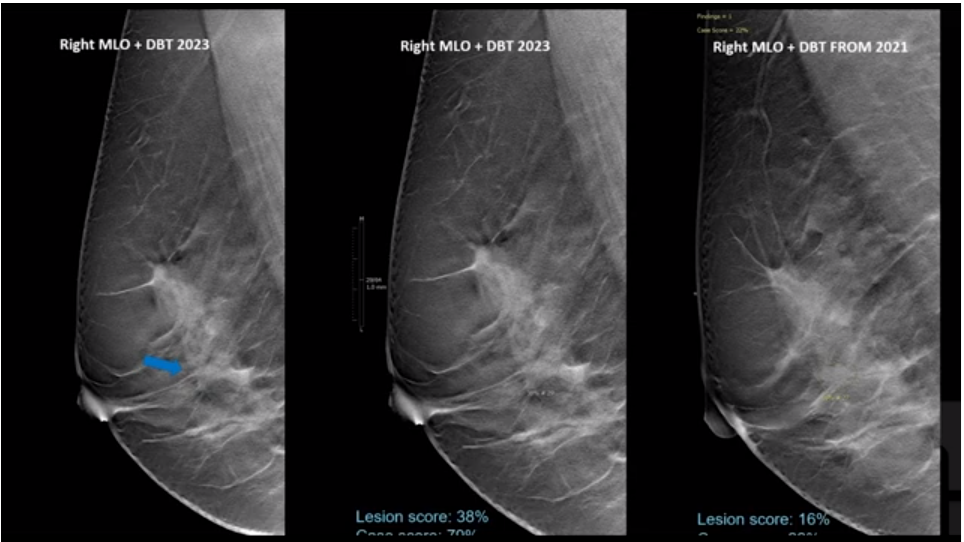
Disclaimer: This case study represents the experience and position of the clinician and doesn’t represent the opinions of iCAD, Inc. Clinicians referenced in the study are responsible for the accuracy of provided data. Refer to the device user manual for detailed product information. To request a copy of the device user manual, please contact iCAD, Inc.
